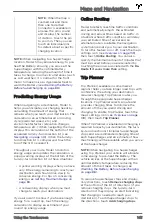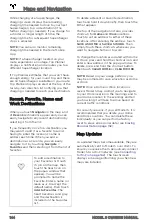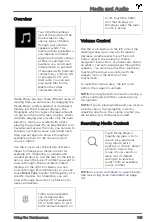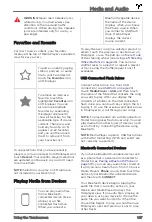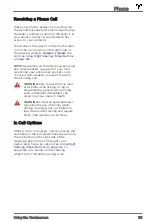
NOTE:
When Model S starts, you may hear
the sound of the compressor as the air
suspension system’s reservoir fills with air.
Adaptive Air Suspension offers a superior ride
quality and allows you to choose a softer or
firmer ride based on your preference. When
carrying loads, the system also maintains a
level height between the front and rear. You
can manually adjust the ride height to suit
your circumstances (for example, you can
raise Model S when driving at low speeds
when you need extra ground clearance, such
as when driving on a steep driveway or ramp,
in deep snow, over large speed bumps,
parking curbs, etc.). You can also specify the
default ride height when driving at higher
speeds.
If a fault is detected that
reduces the performance
of the air suspension
system, a yellow indicator
lights up on the
instrument panel. If the
problem persists, contact
Tesla.
If a fault is detected that
disables the air
suspension system, a red
indicator lights up on the
instrument panel. Contact
Tesla.
Suspension Settings
CAUTION:
Before adjusting the
suspension height, ensure Model S is
clear of all obstacles, above and
below.
With Model S powered on and the brake
pedal pressed, touch
Controls
>
Suspension
on the touchscreen to manually adjust the
ride height, to specify how you want the
suspension to feel, and to choose how you
want adaptive suspension to lower when
driving at higher speeds.
Choose from the following options to
manually change the ride height.
•
VERY HIGH
. When set to Very High, the
suspension automatically lowers to High
when driving speed reaches 56 km/h.
•
HIGH
. When set to High, the suspension
automatically lowers to Standard or Low
(based on the Suspension Lowering
setting described below) when driving
speed reaches 73 km/h.
•
STANDARD
. The Standard setting ensures
optimum comfort and handling under all
loading conditions.
•
LOW
. Lowering the height can improve
aerodynamics and make it easier to load
or unload cargo and passengers.
When manually raising the height of Model S
to improve ground clearance, you should
lower the vehicle when the extra ground
clearance is no longer needed.
CAUTION:
Avoid driving aggressively
(hard accelerations, sharp turns, etc.)
when the suspension is set to
HIGH
or
VERY HIGH
. Doing so can cause
vibration and increase the possibility
of damage.
SUSPENSION LOWERING
: When Model S is
moving above typical driveway or parking lot
speeds, Adaptive Air Suspension
automatically adjusts ride height to improve
aerodynamics and handling. When you
manually raise the ride height, the suspension
automatically adjusts the ride height at
increased driving speeds. Choose from the
following options to specify how you want
the air suspension system to adjust the ride
height:
•
NEVER
. The ride height is set to
STANDARD
for each drive and never
automatically transitions to
LOW
. If you
set the ride height to
HIGH
or
VERY HIGH
and exceed the maximum speed for these
settings, the ride height transitions back
to
STANDARD
. If you manually change
the setting to
LOW
, it resets back to
STANDARD
on your next drive.
•
ALWAYS
. The ride height is set to
LOW
for each drive and if you set it to
HIGH
or
VERY HIGH
and exceed the maximum
speed for these settings, the ride height
transitions back to
LOW
. If you manually
change the setting to
STANDARD
, it
resets back to
LOW
on your next drive.
•
HIGHWAY
. This is the default setting. Ride
height automatically adjusts between
STANDARD
and
LOW
to balance ride
comfort and energy usage.
Air Suspension
152
MODEL S OWNER'S MANUAL






